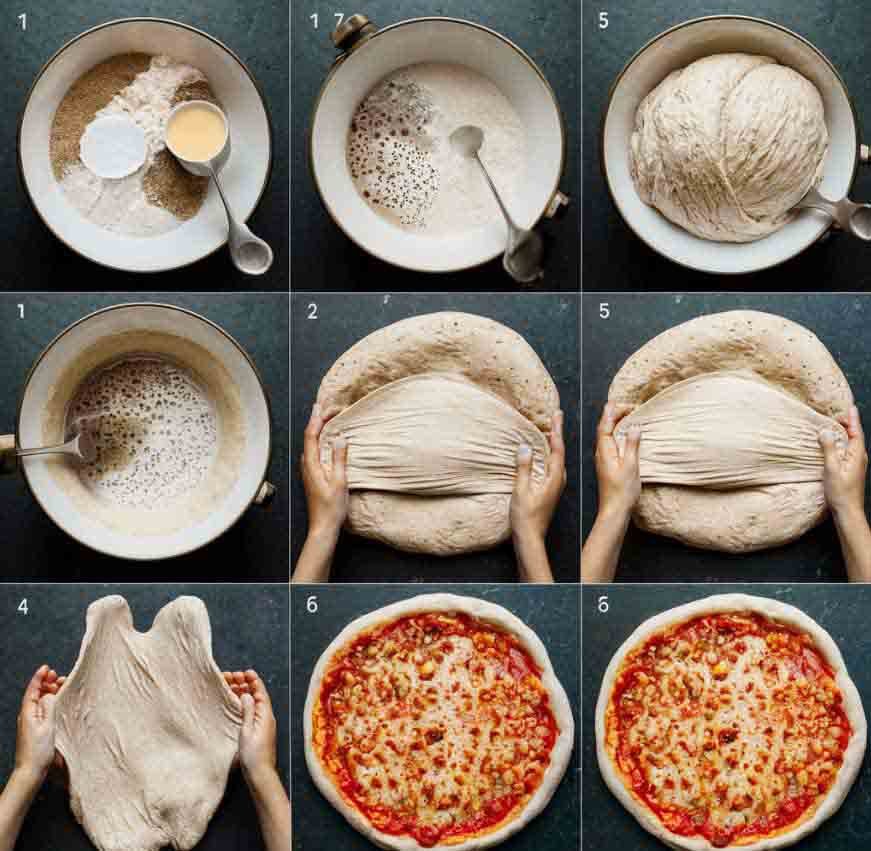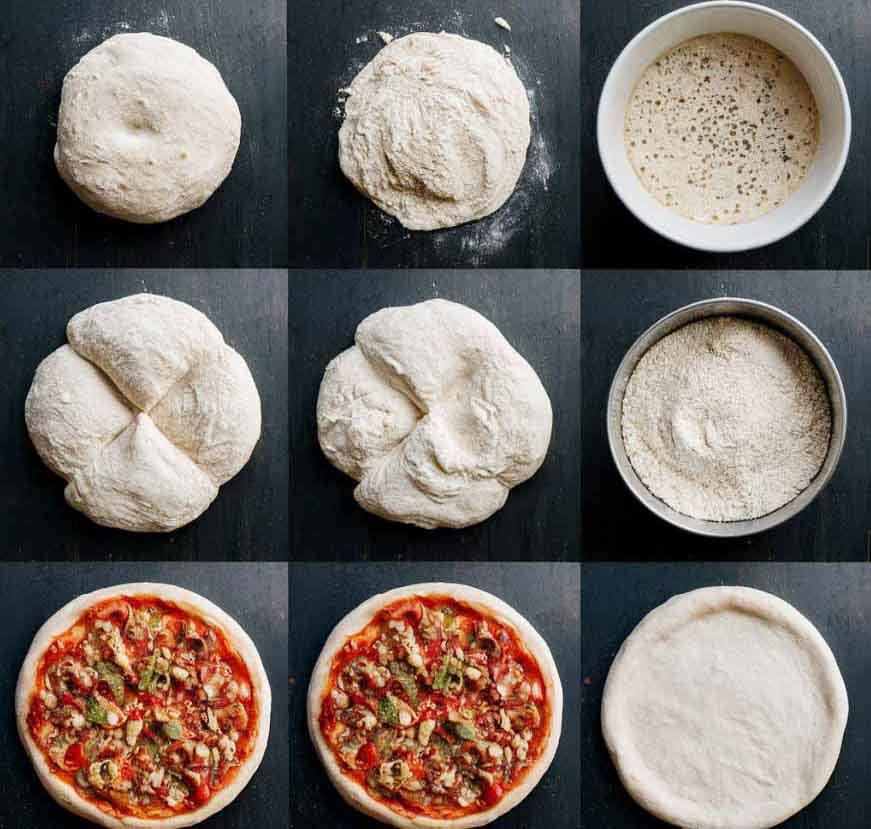
To make sourdough pizza dough, mix starter, flour, water, and salt, then knead and let it ferment. This process yields a tangy, chewy crust.
Crafting the perfect sourdough pizza dough blends the art of patience with the science of fermentation. Avid pizza enthusiasts and home bakers alike revel in the complexity of flavors that only a sourdough base can provide. The key lies in a lively sourdough starter, quality flour, and precise hydration levels.
Balancing these elements leads to a dough that’s both robust in taste and sublime in texture. As the dough slowly rises, the natural yeasts work their magic, creating a pizza crust that’s not just a carrier for toppings but a culinary delight in its own right. This guide will navigate you through the simple yet rewarding journey of creating your own sourdough pizza dough from scratch, ensuring every slice is a testament to your baking prowess.
Introduction to Sourdough Pizza Dough
The art of pizza-making meets ancient tradition with sourdough pizza dough. This dough uses a fermented starter for leavening. It creates a flavorful base for your favorite toppings. Sourdough pizza dough is not just a trend. It’s a return to the roots of baking.
The Rise of Sourdough
Sourdough baking has seen a resurgence in popularity. Social media and health trends have played a part. Home bakers and professional chefs are embracing sourdough for its taste and natural ingredients.
Benefits of Sourdough in Pizza
- Improved Digestion: Lactic acid bacteria make sourdough easier to digest.
- Unique Flavor: Sourdough offers a tangy twist to traditional pizza crusts.
- Longer Freshness: Sourdough pizzas stay fresh longer than their yeast-based counterparts.
Essential Ingredients for Your Dough
Essential Ingredients for Your Dough play a crucial role in making sourdough pizza. Each component affects the texture, flavor, and rise of your dough. Understanding and selecting the right ingredients ensures a delicious outcome. Let’s dive into the essentials for crafting the perfect sourdough pizza dough.
Flour Power: Choosing the Right Type
The type of flour sets the foundation for your dough. High-protein flour, often labeled as bread flour, is ideal. It gives your pizza crust that desirable chewy texture. For a lighter, airier crust, some bakers mix bread flour with all-purpose flour. Here are the best options:
- Bread Flour – High protein for chewiness
- All-Purpose Flour – Mix with bread flour for a lighter crust
Water and Salt: Getting the Ratios Right
Water activates your flour and sourdough starter. Salt controls fermentation and adds flavor. The right balance is key. Use cool water for slow fermentation and warm water for a quicker rise. A general guideline is:
| Ingredient | Ratio |
| Water | 60% to 70% of flour weight |
| Salt | 2% of flour weight |
Adjust these ratios based on your climate and desired dough texture.

Creating Your Sourdough Starter
Embarking on the sourdough journey begins with a starter. This living culture is the heart of your sourdough pizza dough. It requires simple ingredients and patience. Once active, it imparts unique flavors and textures to your pizza crust.
Mixing Your Starter
Begin with equal parts flour and water. Mix them in a clean jar. The consistency should resemble thick paint. This mixture will attract natural yeast. It creates the base for your starter.
- Use whole grain flour for best results.
- Warm water activates the yeast faster.
- Stir with a wooden spoon to incorporate air.
Cover the jar with a cloth. Secure with a rubber band. Let it sit at room temperature. The warm environment helps yeast grow.
Feeding and Maintaining It
Feeding your starter is crucial. It keeps it alive and active. You will feed it daily. Discard half of your starter. Add equal amounts of flour and water to the rest.
- Keep the feeding ratio consistent.
- Use the same type of flour every time.
- After feeding, look for bubbles. They indicate a healthy starter.
Maintain your starter by storing it in a cool place. The refrigerator is ideal between uses. Ensure to feed it once a week if chilled.
Remember: A happy starter means flavorful dough. Your pizza will taste better than ever.
Mixing the Dough: Step by Step
Mastering sourdough pizza dough creates unforgettable flavors and textures. The process starts with mixing the dough. Proper technique ensures a perfect base for your pizza. Let’s dive into the step-by-step method.
Combining Ingredients
Gather your ingredients for the sourdough pizza dough. You will need:
- Active sourdough starter for natural leavening
- Flour, preferably bread or all-purpose
- Water, at room temperature
- Salt to enhance flavor
Begin with a large mixing bowl. Add sourdough starter, water, and half of the flour. Combine these until smooth. Slowly mix in the remaining flour and salt.
Ensure all ingredients are evenly distributed. The dough should form a rough, shaggy mass. Cover the bowl with a damp cloth. Let it rest for 30 minutes. This period is autolysis. It helps gluten formation.
Kneading To Perfection
After the autolysis, it’s time to knead. Use a clean surface. Dust it with flour.
Transfer the dough to the surface. Start kneading by folding the dough over itself. Press down with the heel of your hand. Rotate the dough 90 degrees. Repeat the process.
Knead for about 10 to 15 minutes. The dough should become smooth and elastic. It’s crucial not to rush this step. Proper kneading ensures a light, airy crust.
To check if the dough is ready, do the windowpane test. Stretch a small piece of dough. If it forms a thin, translucent membrane without tearing, it’s perfect.
Place the kneaded dough back into the bowl. Cover it with a damp cloth again. Let it rise until it doubles in size. This can take several hours. Patience is key for the best results.
Once risen, your sourdough pizza dough is ready for shaping. Top with your favorite ingredients. Enjoy a delicious, homemade pizza with a crispy, chewy crust.
Bulk Fermentation Process
The Bulk Fermentation Process is a key step in making sourdough pizza dough. This process helps the dough rise and develop flavor. Let’s explore how to do it right.
Time and Temperature: Key Factors
Time and temperature greatly affect the dough. They control how fast it rises. The perfect balance makes the best dough.
- Time: 6 to 12 hours
- Temperature: 68°F to 75°F (20°C to 24°C)
A warmer room speeds up fermentation. A cooler room slows it down.

What to Look For: Signs of Readiness
Your dough tells you when it’s ready. Look for these signs:
- Size doubles: This means it has enough air.
- Surface bubbles: Tiny bubbles show good fermentation.
- Texture: It should feel soft and slightly sticky.
These signs mean your dough is ready for the next step.
Shaping and Proofing the Pizza Dough
After mixing and fermenting, shaping and proofing are key. They turn your sourdough into a perfect base for pizza. Let’s dive into creating those round, airy bases that will soon crisp up in the oven.
Forming the Dough Balls
Start with a floured surface. Use a dough scraper to divide your bulk dough. Aim for even pieces to ensure uniform cooking later.
- Flour your hands to prevent sticking.
- Grab a piece of the dough and place it on the surface.
- Gently shape into a round ball by folding the edges underneath.
- Repeat this process with all dough pieces.
Rest dough balls on a floured tray. Cover them with a damp cloth to prevent drying.
Final Rise before Baking
Now comes the final rise. This step is crucial for a light, airy crust.
- Let dough balls rise for 1-2 hours at room temperature.
- Ensure they double in size. This indicates they are ready.
- Cover to protect from drafts and to maintain moisture.
Your dough is now ready for stretching and topping. Preheat your oven to its highest setting with the pizza stone inside. The high heat will give your sourdough pizza that signature chew and blistered crust. Enjoy your pizza-making adventure!
Baking Your Sourdough Pizza
Transforming your homemade sourdough into a sumptuous pizza requires skillful baking. Achieving that perfect, crispy crust with a fluffy interior is an art. With the right oven setup and timing, you’ll be well on your way to pizza perfection.
Oven Setup for Optimal Heat
To mimic a professional pizza oven, home bakers need to understand their oven’s capabilities. Preheat your oven to its highest setting, typically between 500-550°F (260-288°C), for at least 30 minutes before baking.
- Place a pizza stone or steel on the middle rack.
- For even heat distribution, check seals and insulation.
- Use an oven thermometer to ensure accurate temperature.
Let the stone or steel absorb the heat to create a crisp base.
Timing for the Perfect Crust
Timing is crucial for that ideal sourdough pizza crust. Place your dough on the hot surface with your favorite toppings.
| Dough Thickness | Baking Time |
| Thin Crust | 4-6 minutes |
| Medium Crust | 6-8 minutes |
| Thick Crust | 8-10 minutes |
Watch closely as the edges puff and the cheese bubbles. Turn the pizza halfway through for an even bake.
Serving Suggestions and Variations
Sourdough pizza dough brings a unique twist to pizza night. With its tangy flavor and chewy texture, it’s a canvas for a range of toppings. Let’s explore some delicious options and creative variations to elevate your homemade pizza experience.
Topping Ideas for Every Palate
Everyone has their favorite pizza toppings. Sourdough pizza welcomes them all. Below are ideas to satisfy various tastes:
- Classic Margherita: Tomato sauce, mozzarella, fresh basil
- Meat Lovers: Pepperoni, sausage, bacon, extra cheese
- Veggie Delight: Bell peppers, onions, mushrooms, olives
- BBQ Chicken: BBQ sauce, chicken, red onions, cilantro
- White Pizza: Olive oil, garlic, ricotta, mozzarella
Feel free to mix and match these toppings to create your perfect pie.
Creative Twists on Traditional Pizza
Want something different? Try these unique takes:
| Twist | Ingredients |
| Taco Pizza | Seasoned ground beef, cheddar, lettuce, tomatoes |
| Buffalo Chicken | Buffalo sauce, chicken, blue cheese, celery |
| Pesto Veggie | Pesto, artichokes, sun-dried tomatoes, feta |
| Hawaiian | Ham, pineapple, jalapeños, mozzarella |
| Breakfast Pizza | Bacon, eggs, cheese, green onions |
These ideas are just the start. Feel free to get creative with your sourdough pizza dough!

Frequently Asked Questions
Is Sourdough Good For Pizza Dough?
Yes, sourdough is excellent for pizza dough. It offers a unique tangy flavor and creates a chewy, airy crust. Its natural fermentation also aids digestion.
What’s The Difference Between Sourdough And Normal Pizza Dough?
The main difference lies in the yeast. Sourdough pizza dough uses natural yeast and lactic acid bacteria from a starter. Normal pizza dough typically uses commercial yeast. This results in sourdough having a tangier taste and a chewier texture compared to the lighter, fluffier texture of regular dough.
What Flour Is Best For Sourdough Pizza?
The best flour for sourdough pizza is high-protein bread flour, which provides the dough with strength and elasticity for a chewy crust.
Is Sourdough Pizza Healthier Than Normal Pizza?
Sourdough pizza can be healthier due to its lower glycemic index and probiotic content, aiding digestion and improving nutrient absorption.
What Is Sourdough Pizza Dough?
Sourdough pizza dough is a type of pizza crust made using a natural yeast culture known as a sourdough starter, which provides a tangy flavor and a chewy texture.
Conclusion
Crafting the perfect sourdough pizza dough might seem daunting, but it’s entirely achievable with the right guidance. Our step-by-step guide demystifies the process, making it accessible for bakers of all levels. Remember, practice makes perfect, and each attempt brings you closer to your ideal crust.
So, why wait? Start your sourdough pizza journey today and impress your friends and family with your baking prowess.


